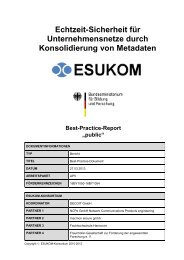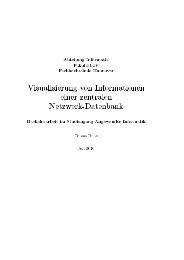Leveraging Trusted Network Connect for Secure ... - esukom
Leveraging Trusted Network Connect for Secure ... - esukom
Leveraging Trusted Network Connect for Secure ... - esukom
Create successful ePaper yourself
Turn your PDF publications into a flip-book with our unique Google optimized e-Paper software.
clients will be authenticate via the management server. There<strong>for</strong>e, the gateway site<br />
does not need adaptations <strong>for</strong> new user. That will be done automatically by the<br />
communication with the management server.<br />
Next to the authentication of the user, the smartphone plat<strong>for</strong>m (hardware and<br />
software configuration) is checked according to the enterprise TNC’s requirements.<br />
After the establishment of a VPN connection, the network access of the mobile device<br />
is limited to the quarantine zone. Within this area, it is only possible to update<br />
software components of the mobile device like anti-virus-software or operating<br />
system patches. The access to other network areas of an enterprise network is<br />
<strong>for</strong>bidden. In<strong>for</strong>mation about the status of the mobile device is available by the access<br />
requestor (AR) on the client-site. The AR includes the network requestor (as a<br />
component of the VPN client), the TNC client (as an interface between the network<br />
access requestor and plug-in software), and the integrity measurement collector<br />
(describes the plug-ins which allows different software products like antivirus<br />
software to communicate with TNC).<br />
In detail, the following points will initiate <strong>for</strong> a mobile device communication (also<br />
depicted in figure 5):<br />
1) A VPN connection is established.<br />
2) The management server (TNC server) initializes an integrity check.<br />
3) The mobile device (TNC client) collects integrity measurements (IM)<br />
in<strong>for</strong>mation using the local Integrity Measurement Clients (IMC) on the<br />
mobile device.<br />
4) The management server (TNC server) <strong>for</strong>wards the IM in<strong>for</strong>mation <strong>for</strong> a<br />
check to the integrity measurement verifier (IMV).<br />
5) The Integrity Measurement Verifier (IMV) checks the IMs and sends the<br />
results with a recommendation to the management server (TNC server).<br />
6) The management server (TNC server) takes access decision und <strong>for</strong>ward<br />
this in<strong>for</strong>mation to the VPN gateway (PEP) and the mobile device (AR).<br />
7) The VPN gateway (PEP) allows or does not allow the access to the network<br />
<strong>for</strong> the mobile device (AR).<br />
Summarized, the integration of the MTM allows a further check of the software<br />
components on the mobile device. This simplifies the detection of rootkits.<br />
Furthermore it is possible to sign and encrypt messages with key material of the<br />
MTM. That means a strong security check of the origin of the in<strong>for</strong>mation.<br />
5 Conclusions<br />
The TNC approach within VOGUE presented in this paper is a viable solution to raise<br />
the security level in mobile networks. Though the core specifications are already<br />
accomplished and various network components are available on the market, there are<br />
still shortcomings and manufacturers differ in their approaches. With Microsoft‘s<br />
“Statement-of-Health Protocol” future interoperability can be reached, but Cisco<br />
Systems will go its own way and will not be interoperable with the standard.<br />
The projects SIMOIT and TNC@FHH are based on TNC too, but include only the<br />
server-side implementation of the standards. The TNC approaches of both projects





